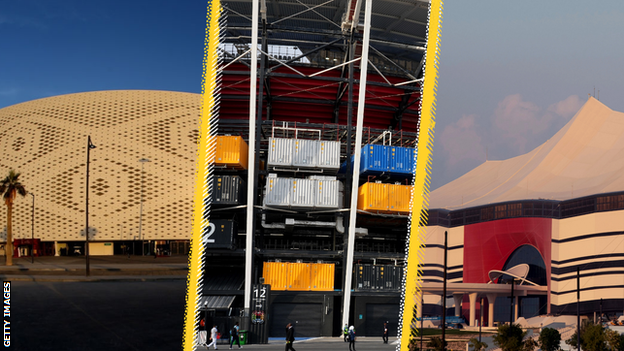World Cup 2022: A guide to the eight World Cup stadiums in Qatar
- Published

Al Thumama, Stadium 974 and Al Bayt are all eye-catching stadiums
A stadium designed like a hat, one made of shipping containers and one in a tent-like structure - the World Cup stadiums are certainly different in Qatar.
The 2022 Fifa World Cup is the smallest nation to host the tournament.
Eight stadiums are separated by roughly an hour's drive and 43 miles at most. Seven of the eight venues have been built from scratch for the tournament, with the other one also extensively redeveloped.
Six of the stadiums will have about half their seats taken up afterwards (and sent to developing countries), while a seventh will be dismantled.
Only one will be the home ground for a football team afterwards.
Organisers say all the stadiums were built with environmental practices in mind, with all earning four or five stars from the Global Sustainability Assessment System (GSAS). The initial budget to build the stadiums and training sites was £4.7bn.
All eight stadiums will be powered by a solar-panel farm and have detailed cooling systems, including outdoor air-conditioning in some.
But since Qatar was awarded the World Cup in 2010, the construction of stadiums has been one of a number of highly controversial elements of its preparations. Amnesty International, external has accused Qatar of "labour abuse and exploitation of its more than two million migrant workers" and says thousands have unexpectedly died.
And a recent Fifa report said infrastructure construction and operational elements would account for almost a quarter of the tournament's carbon emissions. Qatar 2022 as a whole is projected to produce 3.6 million tonnes of carbon dioxide - that is more than some countries' total for a year and an increase from the 2.1 million tonnes of CO2 produced at the 2018 World Cup in Russia.
Here is our guide to the stadiums.
Lusail Stadium (2022)
Capacity: 80,000
Games: 10, including the final
Location: Lusail, 15km north of Doha
This is the Qatar World Cup's flagship stadium, which has only been opened this year (behind schedule).
Lusail will be at the centre of a new £33bn city of the same name which could be home to 200,000 people.
At the end of the World Cup most of the seats will be removed because "Lusail will not need its own football stadium after 2022".
It will become a community hub of schools, shops, health clinics and sporting facilities under the stadium's roof. Remaining upper-tier seating will become part of outdoor terraces for new homes.
Al Bayt Stadium (2021)
Capacity: 60,000
Games: Eight, including the opening match
Location: Al Khor, 35km north of Doha
This stadium is covered by a huge tent-like structure and takes its name from the bayt al sha'ar tents used by nomadic people in the region. The tent and retractable roof will help cool the stadium.
The upper tier of seats will be removed after the World Cup (taking capacity to below 32,000) and given to developing nations. A five-star hotel and shopping centre will be opened in the stadium.
It is the furthest stadium from Doha, although still only a 40-minute drive away.
Stadium 974 (2021)
Capacity: 40,000
Games: Seven, up to last 16
Location: Doha
Even by Qatar 2022 standards, this is a remarkable stadium. It has been built from 974 shipping containers - hence the name - and modular steel. It was previously called Ras Abu Aboud Stadium.
At the end of the World Cup it will be completely dismantled with the parts being used for other projects. The site will become a waterfront development.
Khalifa International Stadium (1976)
Capacity: 45,416
Games: Eight, including third-place play-off
Location: Doha
The only World Cup stadium that existed a few years ago is the Khalifa International Stadium, which was built in 1976 and extensively redeveloped in 2017.
It hosted the World Athletics Championships and Fifa Club World Cup final (which Liverpool won), both in 2019.
The Khalifa is the only World Cup stadium not being partially or fully dismantled afterwards.
Education City Stadium (2020)
Capacity: 40,000
Games: Eight, up to quarter-final
Location: Al Rayyan, 7km west of Doha
The Education City Stadium is located in the middle of several Qatari universities in green space just outside Doha. It is known as the 'Diamond in the Desert' and has an advanced cooling system.
The facade's diamond patterns appear to change colour as the sun moves across the sky.
It hosted the 2021 Fifa Club World Cup final, and sees its capacity halved after the World Cup.
Al Thumama Stadium (2021)
Capacity: 40,000
Games: Eight, up to quarter-final
Location: 12km south of Doha
Another stadium where the capacity will drop to 20,000 once the World Cup is over, with a hotel and mosque opening.
Named after a native tree, its design is based on gahfiya, an Arabic hat.
Al Janoub Stadium (2019)
Capacity: 40,000
Games: Seven, up to last 16
Location: Al Wakrah, 18km south of Doha
The first new World Cup stadium to be completed, back in May 2019. It hosted the 2020 Asian Champions League final.
The design is based on the sails of dhow boats. The stadium has a cooling system so it can be used all year.
Like most of the other stadiums, 20,000 seats will be removed afterwards.
Ahmad Bin Ali Stadium
Capacity: 40,000
Games: Seven, up to last 16
Location: Al Rayyan, 20km west of Doha
This stadium was built on the site of an old ground with the same name - with over 80% of the construction materials reused or recycled - including from the initial ground.
Its glowing facade is "comprised of patterns that characterise different aspects of the country".
It will host Al Rayyan Sports Club, with a 20,000 capacity, after the tournament.